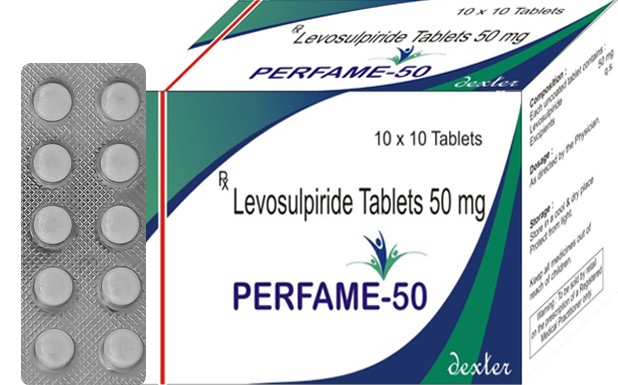Indications and Usage:
Acid-related dyspepsia, Benign gastric ulcer, Duodenal ulcer, Duodenal ulcer associated with h. Pylori, Esophagitis, Gastric ulcer, Gastro-oesophageal reflux disease, Helico-bacter pylori positive duodenal ulcer, NSAID-associated gastric and duodenal ulcers, NSAID-associated gastric and duodenal ulcers (prophylaxis), NSAID-associated gastric or duodenal ulcers, Resistant ulcers, Zollinger-ellison syndrome.
Mechanism of Action:
Levosulpiride is a substituted benzamide, which exerts antidopaminergic (selective dopamine D2 receptors) activity on both central and peripheral levels. It is an atypical neuroleptic and a prokinetic agent.
Absorption: Oral bioavailability is about 30%; peak plasma concentrations after about 3 hr.
Excretion: Mainly via urine. Plasma half-life: 9.7 hr (oral); 4.3 hr (IV).
Drug Interactions:
Reduced bioavailability with sucralfate, aluminium- and magnesium-containing antacids. Effect on GI motility may be antagonised by anticholinergic agents, narcotics and analgesics. Avoid alcohol.
Pharmacodynamics:
Levosulpiride is a selective antagonist at dopamine D2 and D3 receptors. This action dominates in doses exceeding 600 mg daily. In doses of 600 to 1,600 mg levosulpiride shows mild sedating and antipsychotic activity. Its antipsychotic potency compared to chlorpromazine is only 0.2 (1/5). In low doses (in particular 50 to 200 mg daily) its prominent feature is antagonism of presynaptic inhibitory dopamine receptors accounting for some antidepressant activity and a stimulating effect. Therefore, it is in these doses used as a second line antidepressant. Additionally, it alleviates vertigo. The benzamide neuroleptics (including sulpiride, amisulpride, and sultopride) have been shown to activate the endogenous gamma-hydroxybutyrate receptor in vivo at therapeutic concentrations.Sulpiride was found in one study in rats to upregulate GHB receptors.GHB has neuroleptic properties and it is believed binding to this receptor may contribute to the effects of these neuroleptics.
Pharmacokinetics:
Sulpiride is absorbed slowly from the gastrointestinal tract. Its oral bioavailability is only 25 to 35% with marked interindividual differences. The peak plasma concentration is reached 4.5 hours after oral dosing. The usual half-life is 6 to 8 hours. Ninety-two percent is excreted unchanged in the urine. Sulpiride is usually given in 2 or 3 divided doses.
Side Effects:
Amenorrhoea, gynaecomastia, galactorrhoea, changes in libido, and neuroleptic malignant syndrome.[citation needed] Reactions with other drugs include reduced bioavailability with sucralfate, aluminium- and magnesium-containing antacids.[citation needed] It also effects GI motility may be antagonized by anticholinergic agents, narcotics and analgesics
Contraindications:
Phaeochromocytoma, epilepsy, manic states, hyperprolactinaemia, mammary dysplasia, malignant mastopathies, cardiac impairment. GI bleeding, mechanical obstruction or perforation.
Storage:
Store at room temperature, 15-30° C (59-86°F). Keep away from moisture.
